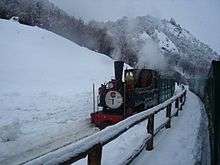Ushuaia
Ushuaia (/uːˈʃwaɪ.ə/; Spanish pronunciation: [uˈswaja]) is the capital of Tierra del Fuego, Antártida e Islas del Atlántico Sur Province, Argentina, and the southernmost city of the country. Ushuaia claims the title of world's southernmost city. Ushuaia is located in a wide bay on the southern coast of Isla Grande de Tierra del Fuego, bounded on the north by the Martial mountain range, and on the south by the Beagle Channel. It is the only municipality in the Department of Ushuaia, which has an area of 9,390 km2 (3,625 sq mi). It was founded on October 12, 1884 by Augusto Lasserre and is located on the shores of the Beagle Channel surrounded by the mountain range of the Martial Glacier, in the Bay of Ushuaia. Besides being an administrative center, it is a light industrial port and tourist hub. Ushuaia is located roughly 1,100 kilometres (680 mi) from the coast of Antarctica and 245 kilometres (152 mi) from the Chilean city of Punta Arenas.
Ushuaia | |
|---|---|
City | |
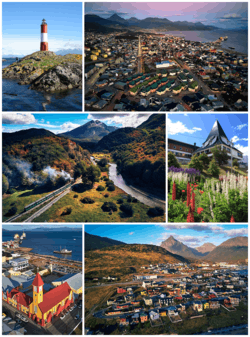 From top, left to right: the Les Eclaireurs Lighthouse, aerial view of the city centre, the Train of the End of the World, Tierra del Fuego Government House, Nuestra Señora de la Merced Church and the city's east coast. | |
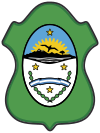 Coat of arms | |
| Motto(s): "Ushuaia, fin del mundo, principio de todo" (Spanish) "Ushuaia, end of the world, beginning of everything" | |
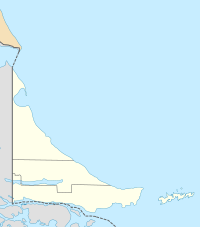 Ushuaia  Ushuaia | |
| Coordinates: 54°48′7″S 68°18′11″W | |
| Country | |
| Province | |
| Department | Ushuaia |
| Founded | 12 October 1884 |
| Founded by | Commodore Lasserre ARA |
| Government | |
| • Type | Municipality |
| • Mayor | Walter Vuoto |
| Area | |
| • Total | 23 km2 (9 sq mi) |
| Elevation | 23 m (75 ft) |
| Population (2010 Census[1]) | |
| • Total | 56,956 |
| • Density | 2,500/km2 (6,400/sq mi) |
| Time zone | UTC−3 (ART) |
| CPA Base | V 9410 |
| Area code(s) | +54 2901 |
| Climate | ET/Cfc |
| Website | www |
Toponymy
The word Ushuaia comes from the Yaghan language: ush and waia ("bay" or "cove") and means "deep bay" or "bay to background". The act creating the subprefecture in 1884 cites the name "Oshovia", one of the many orthographic variations of the word.[2] Its demonym is "Ushuaiense".
The name is often pronounced "u-sua-ia" (Spanish pronunciation: [uˈswaʝa]), an exception to the orthographic rules of Spanish, since the 's' forms a syllable with the following 'u' despite the intervening 'h'. The pronunciation "Usuaía" (accented on the 'i') is erroneous: the prosodic accent is on the first 'a', which is why the word is written without an accent mark.
Symbols
- Shield
The municipality carried out a contest for the election of the image of the City Shield, approving by Decree № 28, in 1971, the design of Vicente Gómez.[3]
- Motto
- Ushuaia, end of the world, beginning of everything
History
The Selk’nam Indians, also called the Ona, first arrived in Tierra del Fuego about 10,000 years ago. The southern group of people indigenous to the area, the Yaghan (also known as Yámana), occupied what is now Ushuaia, lived in continual conflict with the northern inhabitants of the island.[4]
For much of the latter half of the 19th century, the eastern portion of Tierra del Fuego was populated by a substantial majority of nationals who were not Argentine citizens, including a number of British subjects. Ushuaia was founded informally by British missionaries, following previous British surveys, long before Argentine nationals or government representatives arrived there on a permanent basis. The British ship HMS Beagle, under the command of Captain Robert FitzRoy, first reached the channel on January 29, 1833, during its maiden voyage surveying Tierra del Fuego.[5] The city was originally named by early British missionaries[6] using the native Yámana name for the area. Much of the early history of the city and its hinterland is described in Lucas Bridges’s book Uttermost Part of the Earth (1948). The name Ushuaia first appears in letters and reports of the South American Mission Society[6] in England. The British missionary Waite Hockin Stirling[7] became the first European to live in Ushuaia when he stayed with the Yámana people between 18 January and mid-September 1869. In 1870 more British missionaries arrived to establish a small settlement. The following year the first marriage was performed. During 1872, 36 baptisms and 7 marriages and the first European birth (Thomas Despard Bridges) in Tierra del Fuego were registered.[8] The first house constructed in Ushuaia was a pre-assembled 3 room home prepared in the Falkland Islands in 1870 for Reverend Thomas Bridges. One room was for the Bridges family, a second was for a Yámana married couple, while the third served as the chapel.[9]

Thomas Bridges learned the Yaghan (coastal dwellers) language and was a fluent speaker. To a lesser extent he was able to communicate in the Ona (forest dwellers) language. His missionary work was mainly directed at the Yaghans. The word Yamana simply means "people" in the Yaghan language. He wrote a dictionary of the Yaghan language, the original manuscript of which is in the British Museum. As the Yaghans had no ability nor means to write, Thomas Bridges had to construct an alphabet which was suited to the phonetics of the language. The original manuscript was lost three times but recovered and almost published under an incorrect name. More than one alphabet has been used over the years in the rendering of this dictionary. The odyssey of the manuscript covered nearly half a century before it was finally published. Natalie Goodall was instrumental in reprinting the dictionary in 1987 and providing valuable insights into the history of Thomas Bridges' work. Copies of the dictionary provide material on the letters and pronunciations used which in many respects differ from the alphabet used in the English language. (Ref: A de la Rue).
During 1873, Juan and Clara Lawrence, the first Argentine citizens to visit Ushuaia, arrived to teach school. That same year Julio Argentino Roca, who later served as Argentine President twice, promoted the establishment of a penal colony for re-offenders, modeled after one in Tasmania, Australia, in an effort to secure permanent residents from Argentina and to help establish Argentine sovereignty over all of Tierra del Fuego.[10][11] But only after the Boundary treaty of 1881 between Chile and Argentina did formal efforts get under way to establish the township and its prison.
During the 1880s, many gold prospectors came to Ushuaia following rumors of large gold fields, which proved to be false.[12][13] On 12 October 1884, as part of the South Atlantic Expedition, Commodore Augusto Lasserre established the sub-division of Ushuaia,[14] with the missionaries and naval officers signing the Act of Ceremony. Don Feliz M Paz was named Governor of Tierra del Fuego and in 1885 named Ushuaia as its capital. In 1885 the territory police was organized under Antonio A. Romero with headquarters also in Ushuaia. But it was not until 1904 that the Federal Government of Argentina recognized Ushuaia as the capital of Tierra del Fuego.[15]
Ushuaia suffered several epidemics, including typhus, pertussis, and measles, that much reduced the native population. But because the Yámana were not included in census data, the exact numbers lost are not known. The first census was held in 1893, which recorded 113 men and 36 women living in Ushuaia. The prison was formally announced in an Executive order by the then-Acting President Roca in 1896.[8] By 1911 the Yámana had all practically disappeared, so the mission was closed.[16] The population grew to 1,558 by the 1914 census.
In 1896 the prison received its first inmates, mainly re-offenders and dangerous prisoners transferred from Buenos Aires, but also some political prisoners. A separate military prison opened in 1903 at the nearby Puerto Golondrina. The two prisons merged in 1910, and that combined complex still stands today.[7][17] Thus, during the first half of the 20th century, the city centered around the prison built by the Argentine government to increase the Argentine population and to ensure Argentine sovereignty over Tierra del Fuego.[10][11] The prison was intended for repeat offenders and serious criminals, following the example of the British in Tasmania and the French in Devil's Island.[11] Escape from Tierra del Fuego was similarly difficult, although two prisoners managed to escape into the surrounding area for a few weeks.[10] The prison population thus became forced colonists and spent much of their time building the town with timber from the forest around the prison. They also built a railway to the settlement,[18] now a tourist attraction known as the End of the World Train (Tren del Fin del Mundo), the southernmost railway in the world.
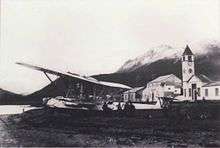
The prison operated until 1947, when President Juan Perón closed it by executive order in response to the many reports of abuse and unsafe practices.[7][17] Most of the guards stayed in Ushuaia, while the prisoners were relocated to other jails farther north. After the prison closed, it became a part of the Base Naval Ushuaia (in Spanish), functioning as a storage and office facility until the early 1990s.[19] Later it was converted into the current Museo Maritimo de Ushuaia.[20]
The naval base at Ushuaia was active during the Falklands War of 1982. The Argentine cruiser ARA General Belgrano, subsequently sunk by the British Fleet, sailed from the Port of Ushuaia, where a memorial was erected in February 1996.
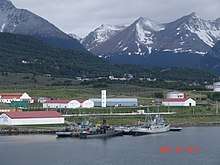
Geography
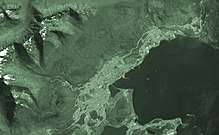
Physical geography
Location
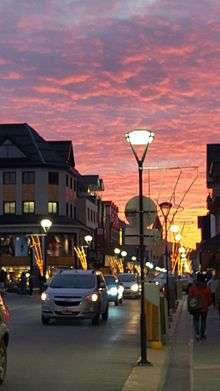
Ushuaia is located on Ushuaia Bay at 6 meters above sea level, surrounded to the west, north, and east by the Andes Fueguinos. It is the only city accessed from the rest of the country by crossing part of the Andes mountain range that runs along the southern edge of Tierra del Fuego. National Route 3 crosses the Sierra Alvear through the Garibaldi Pass to enter the Carabajal Valley, where it follows the Olivia River through the Sierra Sorondo to the Beagle Channel and Ushuaia Bay.[21][22][23] For this reason, in Argentina it is considered the only trans-Andean city (ciudad trasandina).
Ushuaia has long been described as the southernmost city in the world.[24][25] While there are settlements farther south, the only one of any notable size is Puerto Williams, a Chilean settlement of some 2,000 residents.[26] As a center of population, commerce, and culture, and as a town of significant size and importance,[27] Ushuaia however clearly qualifies as a city. A 1998 article in the newspaper Clarín[28] reported that the designation "Southernmost city in the world" had been transferred to Puerto Williams by a joint committee from Argentina and Chile, but this was denied by Argentine authorities,[29][30] and the Secretariat of Tourism of Argentina continues to use the slogan in official documentation and web sites.[31]
Climate
Ushuaia features a significantly ocean-moderated mild tundra climate (Köppen: ET); bordering on a subpolar oceanic climate (Köppen: Cfc), with both extremely mild winters and summers (average temperature remains above 0 °C and below 10 °C year round). Vegetation around the city thus does not resemble typical tundra but is instead heavily forested. Temperatures at the Ushuaia – Malvinas Argentinas International Airport average 1.3 °C (34.3 °F) in the coolest month (July), and 9.7 °C (49.5 °F) in the warmest month (January). The record low is −21.0 °C (−5.8 °F) in July, and the record high is 29.5 °C (85.1 °F) in January.[32] On average, the city experiences 146 days of precipitation a year, with many cloudy and foggy days, averaging 206 cloudy days a year.[33] This results in Ushuaia receiving an average of 3.93 hours of sunshine per day (an annual total of 1,434 hours) or about 30.2% of possible sunshine.[32] Despite receiving only 529.7 millimetres (21 in) average annual precipitation, Ushuaia is very humid with an average humidity of 77%.[34]
Summers tend to be cloudy and windy, with maximum temperatures averaging around 14 °C (57 °F) during the day and about 5 °C (41 °F) at night.[33] Temperatures of 20 °C (68 °F) or more occur only on a handful of days, and night frost is always possible, as well as days below 10.0 °C (50 °F). Temperatures gradually diminish during the autumn, to reach maximum temperatures of about 4.5 °C (40 °F) and minimum temperatures of −1.4 °C (29 °F) in winter, with frequent snow, sleet and rain showers.[33] Some winters may bring extended periods of frost and snow with a perpetual snowcover, whereas other winters might just bring snowstorms followed by thaws. Temperatures then very slowly recover during the spring, but snow showers and frost are a common occurrence until the beginning of the summer in December, and they might occur even in midsummer.
The southwestern winds make the outer islands wetter, reaching 1,400 mm (55 in) at Isla de los Estados (Staten Island). Because temperatures are cool throughout the year, there is little evaporation. Snow is common in winter and regularly occurs throughout the year. Ushuaia occasionally experiences snow in summer (from November to March). Due to its high southern latitude, the city's climate is influenced by Antarctica, and the duration of daylight varies significantly, from more than 17 hours in summer to just over 7 hours in winter.
| Climate data for Ushuaia Airport (1981–2010, extremes 1901–present)[lower-alpha 1] | |||||||||||||
|---|---|---|---|---|---|---|---|---|---|---|---|---|---|
| Month | Jan | Feb | Mar | Apr | May | Jun | Jul | Aug | Sep | Oct | Nov | Dec | Year |
| Record high °C (°F) | 29.5 (85.1) |
28.9 (84.0) |
25.6 (78.1) |
22.2 (72.0) |
20.3 (68.5) |
19.0 (66.2) |
17.5 (63.5) |
18.0 (64.4) |
22.3 (72.1) |
21.2 (70.2) |
26.3 (79.3) |
29.0 (84.2) |
29.5 (85.1) |
| Average high °C (°F) | 14.5 (58.1) |
14.1 (57.4) |
12.1 (53.8) |
9.8 (49.6) |
6.9 (44.4) |
4.2 (39.6) |
4.6 (40.3) |
6.1 (43.0) |
8.1 (46.6) |
10.5 (50.9) |
12.2 (54.0) |
13.3 (55.9) |
9.7 (49.5) |
| Daily mean °C (°F) | 9.7 (49.5) |
9.5 (49.1) |
8.0 (46.4) |
6.0 (42.8) |
3.8 (38.8) |
1.7 (35.1) |
2.4 (36.3) |
2.9 (37.2) |
4.2 (39.6) |
6.3 (43.3) |
7.7 (45.9) |
8.8 (47.8) |
5.9 (42.6) |
| Average low °C (°F) | 5.6 (42.1) |
5.6 (42.1) |
4.3 (39.7) |
2.9 (37.2) |
1.1 (34.0) |
−1.2 (29.8) |
−1.1 (30.0) |
−0.3 (31.5) |
0.6 (33.1) |
2.3 (36.1) |
3.6 (38.5) |
4.6 (40.3) |
2.3 (36.1) |
| Record low °C (°F) | −2.0 (28.4) |
−4.0 (24.8) |
−4.3 (24.3) |
−7.3 (18.9) |
−20.2 (−4.4) |
−18.2 (−0.8) |
−21.0 (−5.8) |
−19.6 (−3.3) |
−10.6 (12.9) |
−6.1 (21.0) |
−6.0 (21.2) |
−3.7 (25.3) |
−21.0 (−5.8) |
| Average precipitation mm (inches) | 49.5 (1.95) |
42.1 (1.66) |
46.8 (1.84) |
55.9 (2.20) |
47.6 (1.87) |
56.4 (2.22) |
40.1 (1.58) |
36.0 (1.42) |
34.5 (1.36) |
36.1 (1.42) |
41.3 (1.63) |
50.7 (2.00) |
537.0 (21.14) |
| Average precipitation days (≥ 0.1 mm) | 17.1 | 14.2 | 14.9 | 15.8 | 14.0 | 14.2 | 15.3 | 14.4 | 13.3 | 14.4 | 16.0 | 16.8 | 180.4 |
| Average snowy days | 0.3 | 0.1 | 2 | 2 | 5 | 8 | 7 | 9 | 7 | 5 | 3 | 1 | 49.4 |
| Average relative humidity (%) | 75 | 76 | 78 | 80 | 81 | 82 | 82 | 80 | 76 | 73 | 72 | 74 | 77 |
| Mean monthly sunshine hours | 167.4 | 146.9 | 133.3 | 102.0 | 68.2 | 42.0 | 55.8 | 83.7 | 123.0 | 164.3 | 180.0 | 167.4 | 1,434 |
| Percent possible sunshine | 32.0 | 34.5 | 33.5 | 31.5 | 25.7 | 18.5 | 22.5 | 27.5 | 34.0 | 37.5 | 37.0 | 28.5 | 30.2 |
| Source 1: NOAA (humidity 1961–1990),[34] World Meteorological Organization (average high and low, and precipitation),[35] Secretaria de Mineria (extremes and sun, 1901–1990)[32] | |||||||||||||
| Source 2: Servicio Meteorológico Nacional (extremes),[36] UNLP (snowfall data),[37] Tokyo Climate Center (mean temperatures 1981–2010)[38] | |||||||||||||
Economy
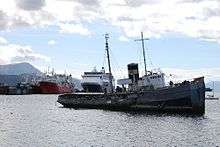
The main economic activities are fishing, natural gas and oil extraction , sheep farming and ecotourism.
Tourism
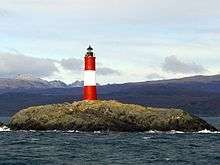
Tourist attractions include the Tierra del Fuego National Park and Lapataia Bay. The park can be reached by highway, or via the End of the World Train (Tren del Fin del Mundo) from Ushuaia. The city has a museum of Yámana, English, and Argentine settlement, including its years as a prison colony. Wildlife attractions include local birds, penguins, seals, and orcas, many of these species colonizing islands in the Beagle Channel. There are daily bus and boat tours to Harberton, the Bridges family compound, Estancia Harberton. Tours also visit the Les Eclaireurs Lighthouse. Les Eclaireurs is sometimes confused with the "Lighthouse at the End of the World" (Faro del fin del mundo) made famous by Jules Verne in the novel of the same name; but the latter lies some 200 mi (320 km) east of Ushuaia on Isla de los Estados (Island of the States).
Manufacturing
Ushuaia's industrial sector, led by the Grundig Renacer electronics factory, is among the largest in Patagonia.
Arts and culture
Since 2007 Ushuaia has hosted the Bienal de Arte Contemporáneo del Fin del Mundo (Biennial of Contemporary Art at the End of the World), created and organized by the Patagonia Arte & Desafío Foundation under the rubric "South Pole of the Arts, Sciences, and Ecology". The Bienal has gathered over one hundred artists from five continents addressing the motto "think at the End of the World that another world is possible". As a pedagogical project it encourages students at all levels to "think about a better world".
Sports
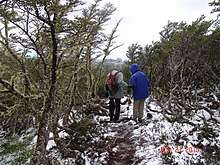
As in most of Argentina, football is a popular sport in Ushuaia, and in 2010 the TV show FIFA Mundial did a story about the sport's development in this locality. In 2015 Ushuaia hosted the first PATHF Snow Handball Panamerican Championship.[39]
Ice hockey
A popular sport in Ushuaia is ice hockey, and low temperatures all year long make the city a perfect spot for practicing it outdoors. In 2010 the city opened an outdoor short track and ice hockey Olympic-Size Ice rink (30 by 60 metres (98 by 197 feet)),[40] the first of its kind in South America. After this Argentina became the first South American nation to be upgraded from affiliate to associate member status of the International Ice Hockey Federation (IIHF).[41]
Since 2005 the Municipality of Ushuaia and the Argentinean Ice Hockey Federation (FAHH) organize the yearly End of the World Cup (Copa del Fin del Mundo) that has gathered ice hockey teams from Ushuaia, Buenos Aires, Punta Arenas and Sao Paulo and includes seven different competitions: one for men, one for women, four junior categories and an international tournament.[42]
Beside the local league and the Copa del Fin del Mundo, in 2016 the city hosted the first ice hockey Patagonian Championship, with teams from Ushuaia, Río Grande and Punta Arenas. After the tournament it was announced a new plan to build a roof over the ice rink.[43]
Ushuaia has two rival teams: Club Andino de Ushuaia (CAU) and Los Ñires.[44]
Skiing
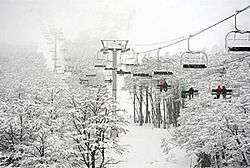
Several ski areas are located near Ushuaia including Glacier El Martial (on Martial Mountains) and Cerro Castor. Opened in 1999,[45] Cerro Castor is the southernmost full-fledged ski resort in the world.[46][47] On Cerro Castor, it is possible to ski just 200 metres (660 feet) above sea level. The summit reaches an elevation of 1,003 metres (3,291 feet) above sea level, and consistently cool temperatures allow the longest skiing season in South America. Winter temperatures fluctuate between 0 to −5 °C (32.0 to 23.0 °F). It has ten elevation facilities and 28 ski trails for all skill levels. There are cafeterias, mountain huts, a ski school, a first aid room and a forest of beech.[48] Snowboarding, sledding, and snowshoeing are also available at Cerro Castor, in addition to alpine skiing.[49] It is located on the southern side of Cerro Krund,[50] 27 kilometres (17 miles) north of Ushuaia. The ski season is typically between June through October. In 2012 Cerro Castor hosted the FIS Freestyle Slopestyle World Cup, organized by the International Ski Federation (FIS),[51] and in 2015 it hosted the Interski Congress and World Cup, organized by the International Ski Instructors Association, which was its first ever event in the Southern Hemisphere.[52]
The glacier is popular even during the summer months, when the chairlift operates in both directions. Hiking trails lead from the city's edge to the base of the glacier, which has retreated considerably over the past century, as shown in photographs on display at the Antarctic Museum of Ushuaia.[53]
The Valley of Tierra Mayor and the Francisco Jerman Nordic Ski Area, located 20 km and 5 km away from Ushuaia respectively, are popular Cross-Country venues. Since 1986 Tierra Mayor hosts the annual Marchablanca, a 21 km traditional race organized by the Club Andino Ushuaia,[54] and the Ushuaia Loppet, a full distance marathon that is one of the 20 members of the Worldloppet Ski Federation. Usually this race starts the Federation's Marathon Series in August.[55]
In October 2014 the Argentine Olympic Committee (COA) revealed the plan to use the 2018 Summer Youth Olympics, to be held in Buenos Aires, as the launchpad for a bid in the near future. The Committee identified Argentina's south-eastern region of Patagonia, which comprises the southern section of the Andes mountains, as a possible location to host the Winter Games.[56] In 2010 it was suggested that Ushuaia would be the main option for a bid.[57] Before the 2018 Summer Youth Olympics, International Olympic Committee President Thomas Bach visited Ushuaia and talked about the possibility of holding the 2024 Winter Youth Olympics here.[58]
Government
The city government consists of a Mayor (executive), City Council (seven members, legislative) and the Tribunal de Faltas (small court, judicial).
Education
Ushuaia has twelve secondary schools, four of which also provide adult education.[59][60] The Colegio Nacional de Ushuaia[61] is one of the newest schools in the city and it was modeled after the Colegio Nacional de Buenos Aires. Another important secondary school is Colegio Diocesano Monseñor Miguel Ángel Alemán, which takes its name after the Monsignor of the same name.
The National University of Patagonia San Juan Bosco[62] operates a campus in Ushuaia, with Faculties of Engineering, Economics and Humanities, and Social Sciences.
The National University of Tierra del Fuego, inaugurated in 2010, has its headquarters in Ushuaia.
Media
Transportation

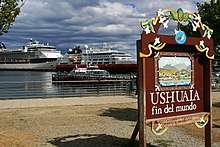
Air
Ushuaia receives regular flights at Ushuaia – Malvinas Argentinas International Airport from El Calafate, Buenos Aires and Santiago, Chile.
Sea
In addition to being a vacation destination for local and international tourists, Ushuaia is also the key access point to the Southern Ocean, including subantarctic islands such as South Georgia and the South Sandwich Islands and Antarctic islands such as the South Orkney Islands and the South Shetland Islands. Its commercial pier is the major port of departure in the world for tourist and scientific expeditions to the Antarctic Peninsula. Cruise ships visiting the Falkland Islands and Antarctica dock at the port, as well as Princess Cruises, Holland America Line, and Celebrity Cruises, which transit between Valparaíso, Chile, to Buenos Aires and beyond. Albatros Expeditions, Antarpply Expeditions, Global Maritime, Hurtigruten, Lindblad Expeditions, Orient Lines, Quark Expeditions, Regent Seven Seas Cruises, and other passenger and freight lines provide regularly scheduled services between Ushuaia and local seaports and settlements. Australis Cruises provides regular service between Ushuaia and Punta Arenas from September to April. Tourists can also visit Cape Horn (in Chilean waters) by boat or helicopter.
Road
The southern terminus of the Pan-American Highway, which is also the southern end of Argentina National Route 3, is located in Tierra del Fuego National Park.
Health care
Located at the corner of Avenida 12 de Octubre and Maipú, the Hospital Gobernador Ernesto M. Campos[67] is one of the big health care centers in Ushuaia; the other one is private and it is called Clínica San Jorge.
Ecology
- Flora
Ushuaia is surrounded by Magellanic subpolar forests. On the hills around the town, the following indigenous trees are found: Drimys winteri (Winter's bark), Maytenus magellanica (Hard-log Mayten) and several species of Nothofagus (Southern Beech). Trees in Ushuaia tend to follow the wind direction, and are therefore called "flag-trees", for their uni-directional growth pattern.
Filmography
Ushuaïa, le magazine de l'Extrême was the name of a television program, presented by Nicolas Hulot and broadcast on the French TV channel TF1 from September 1987 to June 1995. The show is known in English as Ushuaia: The Ultimate Adventure, and this language's version was hosted by Perri Peltz and was shown on NBC, CNBC, and international affiliates of the Discovery Channel.. The city was also featured on the American CBS reality television show The Amazing Race in the fourth leg of Season 11.[68]
In 2014, BBC car program Top Gear visited Ushuaia at the conclusion of their "Patagonia Special", with the intent of constructing a stadium and playing a game of car football there. Before they could do so, however, they were chased out of the city (and subsequently across the border into Chile) by mobs of people angered by an apparent reference to the Falklands War encoded in the registration plate of presenter Jeremy Clarkson's vehicle (H982 FKL).
Several scenes in the 2015 film The Revenant, directed by Alejandro González Iñárritu, were shot in Ushuaia from July through November, 2014.[69][70][71]
Notable people
- Four children of Thomas Bridges (c. 1842–1898) an Anglican missionary and linguist,[72] the first to set up a successful mission to the indigenous peoples in Tierra del Fuego
Same-sex marriage
On December 29, 2009, the first same-sex couple to marry in Latin America were married in Ushuaia.[73] Although the Civil Code of Argentina at that time did not allow marriage between people of the same sex, Governor Fabiana Ríos issued a special decree allowing the couple to wed there. The marriage was annulled when the decree was reversed by Tierra del Fuego's judiciary, since the Civil Code did not support it.[74] Same sex marriage became legal nationwide in Argentina a few months later, on July 15, 2010, after the approval of a gender-neutral bill by the Argentine National Congress.
Gallery
 Port
Port Harbor
Harbor Lighthouse
Lighthouse City view
City view Penguins on Martillo Island
Penguins on Martillo Island Los Lobos Island
Los Lobos Island
International relations
See also
References
- "INDEC (Argentine Ministry of Economics) 2010 Census results" (PDF). Retrieved 21 November 2011.
- Canclini, Arnoldo (1984). Ushuaia 1884–1984 (in Spanish) (1 ed.). Hanis Association. p. 529. OCLC 252895269.
Because of the difficulty of native pronunciation (...) the variations of the spelling are enormous. (...) In 1938, the book Geographical nomenclature and technical terminology, Santiago, Chile, reported eighteen variants.
- Funcardio (9 March 2010). "The Shield of the City of Ushuaia". Archived from the original on 31 July 2012.
- "The Selk'nam (Ona)". Hunter-Gatherer Wiki. Anthropology Department, Ohio State University. Retrieved 28 November 2010.
- Beagle Channel
- Right Rev. Edward Francis Every, D.D. (1915). "The South American Missionary Society". Society for Promoting Christian Knowledge, 1915, London. Retrieved 10 January 2017.
- "roughguides". Retrieved 28 November 2010.
- "Historia de Ushuaia". Archived from the original on 31 May 2011. Retrieved 28 November 2010.
- "Spanish Tierra del Fuego". Archived from the original on 14 May 2009. Retrieved 28 November 2010.
- "Prison synonymous for suffering" (PDF) (in Spanish). Archived from the original (PDF) on 22 July 2011. Retrieved 28 November 2010.
- "Spanish Historia de Ushuaia". Retrieved 28 November 2010.
- "Spanish Historia de Ushuaia". Retrieved 28 November 2010.
- "Tierra del Fuego Province". Retrieved 28 November 2010.
- "Cape Horn Patagonian News". Retrieved 28 November 2010.
- "tierradelfuego". Archived from the original on 31 May 2011. Retrieved 28 November 2010.
- "Ona People". Retrieved 28 November 2010.
- Vittar, Daniel; Redaccion Clarin (22 May 2006). "Viaje a la Carcel de Ushuaia Historias macabras en el museo del fin del mundo". Grupo Clarin. Retrieved 28 November 2010.
- "Noticiaspatagonicas". Archived from the original on 31 August 2010. Retrieved 28 November 2010.
- "rionegro". Retrieved 28 November 2010.
- "Museo Maritimo de Ushuaia". Retrieved 28 November 2010.
- von der Fecht, Florian; Sylvia Iparraguirre. Tierra del Fuego. A biography of the end of the world. 172: "They separated Ushuaia from another center populated by miles and miles of impassable lands. The mountain range of the Andes was a kind of wall that was incommunicate, by land, of Punta Arenas and Rio Grande.
- Arias, Mariela (3 July 2011). "Garibaldi Pass: on the other side of the Andes". Archived from the original on 4 January 2018. Retrieved 21 June 2012.
Msnm in a north-south direction, we are in the only place in the Argentine territory west of the Andes, which makes Ushuaia the only trans-Andean city in Argentina. The Garibaldi Pass, where The National Route N ° 3 crosses the mountain range of the Andes to leave us still in Argentine soil.
- "Cavalcade Step Bridges". 21 June 2012. Archived from the original on 6 April 2008. Retrieved 10 January 2017.
you will cross the old road that crosses the Cordillera de Los Andes, linking Estancia Harberton with Estancia Viamonte. Path that crosses the Andes, opened in 1900 ... Cerro Spion Cop announces the beginning of the crossing of the mountain range. Walking along narrow steps between pebbles, we reach the highest point of the path, located at 790 m. above sea level. From there, the descent presents big turbades and you will begin to see the Beagle Channel.)
- "Introduction to Ushuaia". The New York Times. 20 November 2006. Retrieved 28 November 2010.
- "Ushuaia". Britannica. Retrieved 28 November 2010.
- "Puerto William". Archived from the original on 7 August 2008. Retrieved 28 November 2010.
Su población, de aproximadamente 1.700 habitantes, esta compuesta casi en su totalidad, por personal de la Armada y sus familiares
- "City". Retrieved 28 November 2010.
- "Ushuaia ya no sera la cuiduad mas Austral de Mundo". Retrieved 28 November 2010.
- "Argentine Congress, Lower House". Archived from the original on 13 February 2012. Retrieved 28 November 2010.
- "Argentine Congress Nov 11,1998 Dictamen CXXXVII". Archived from the original on 2 August 2012. Retrieved 28 November 2010.
se expresa preocupación ante la difusión de la información publicada sobre el traspaso del slogan que caracteriza a la ciudad de Ushuaia como la ciudad mas austral del mundo, a la población chilena de Puerto William
- "Secretariat of Tourism of Argentina". Retrieved 28 November 2010.
- "Provincia de Tierra del Fuego – Clima Y Meteorologia: Datos Meteorologicos Y Pluviometicos" (in Spanish). Secretaria de Mineria de la Nacion (Argentina). Archived from the original on 19 January 2015. Retrieved 7 April 2013.
- "Datos Estadisticos (Periodo 1981–1990)" (in Spanish). National Meteorological Service of Argentina. Retrieved 17 November 2012.
- "Ushuaia AERO I Climate Normals 1961–1990". National Oceanic and Atmospheric Administration. Retrieved 20 October 2015.
- "World Weather Information Service – Ushuaia". World Meteorological Organization. Archived from the original on 23 March 2017. Retrieved 23 March 2017.
- "Clima en la Argentina: Guia Climática por localidades". Caracterización: Estadísticas de largo plazo (in Spanish). Servicio Meteorológico Nacional. Retrieved 28 January 2018.
- "Datos bioclimáticos de 173 localidades argentinas". Atlas Bioclimáticos (in Spanish). Universidad Nacional de La Plata. Retrieved 5 April 2014.
- "Normals Data: USHUAIA AERO - ARGENTINA Latitude: 54.80°S Longitude: 68.32°W Height: 28 (m)". Japan Meteorological Agency. Archived from the original on 13 January 2019. Retrieved 13 January 2019.
- "URU se llevó el I Panamericano de Snow Handball / URU won the I Snow Handball Panamerican Ch". PATHF. Retrieved 19 September 2015.
- IIHF. "Ice age in Argentina". iihf.com. Retrieved 19 November 2015.
- "Kyrgyzstan Joins IIHF, Argentina Recognized for Ice Hockey - Puck Worlds". puckworlds.com. 14 May 2011. Retrieved 19 November 2015.
- "Historia – Copa Fin del Mundo". copafindelmundo.com.ar. Archived from the original on 20 November 2015. Retrieved 19 November 2015.
- "Emerging from Devil's Lagoon". IIHF. Retrieved 25 August 2016.
- "Emerging from Devil's Lagoon". IIHF. 20 July 2016. Retrieved 20 July 2016.
- "Cerro Castor, Ushuaia". Patagonia.com.ar. Retrieved 28 November 2010.
- "Cerro Castor". Archived from the original on 7 June 2011. Retrieved 28 November 2010.
- "Cerro Castor". Welcome Argentina. Retrieved 28 November 2010.
- "Cerro Castor". Argentour. Retrieved 28 November 2010.
- "Cerro Castor Centro de Ski, Argentina". Argentinaski.com. Archived from the original on 27 May 2009. Retrieved 28 November 2010.
- José María Redondo Vegla. "EL GLACIAR ROCOSO DE CERRO KRUND, TIERRA DEL FUEGO, ARGENTINA". 2001-2010 Universidad de La Rioja. Retrieved 28 November 2010.
- "Archived copy". Archived from the original on 23 January 2013. Retrieved 10 June 2015.CS1 maint: archived copy as title (link)
- "Home - Interski 2015 Argentina". interski-2015.org. Archived from the original on 15 November 2015. Retrieved 19 November 2015.
- "Museo Antártico Ushuaia Dr. José María Sobral". Retrieved 28 November 2010.
- "Marchablanca Edición 2015 – Club Andino Ushuaia. Tierra del Fuego. Argentina". clubandinoushuaia.com.ar. Retrieved 19 November 2015.
- "Snow comes to the southernmost city of the world". fis-ski.com. Retrieved 19 November 2015.
- "Patagonia put forward as potential Winter Olympic bid by Argentina". insidethegames.biz. Retrieved 19 November 2015.
- "COI no descartó opción de que Chile o Argentina organicen los Juegos de Invierno". latercera.com. 28 July 2010. Archived from the original on 2 October 2013. Retrieved 10 January 2017.
- "Sueños y Secreto de los hombres que trajeron los Juegos a la ciudad". La Nación. October 2018. Retrieved 1 October 2018.
- "Ministerio de Educación, Cultura, Ciencia y Tecnología - Escuela de Adultos". Archived from the original on 18 August 2010. Retrieved 28 November 2010.
- "quefuede". Archived from the original on 31 May 2011. Retrieved 28 November 2010.
- "Colegio Nacional de Ushuaia". Archived from the original on 21 December 2008. Retrieved 28 November 2010.
- "Universidad Nacional de la Patagonia San Juan Bosco". Retrieved 28 November 2010.
- "Channel 11". Archived from the original on 2 September 2010. Retrieved 28 November 2010.
- "Channel 13". Archived from the original on 31 August 2010. Retrieved 28 November 2010.
- "eldiariodelfindelmundo". Retrieved 28 November 2010.
- "Diarioprensaushuaia". Retrieved 28 November 2010.
- "El Hospital Regional Ushuaia". Archived from the original on 25 June 2010. Retrieved 28 November 2010.
- Adebowale, Temi (17 April 2019). "Phil Keoghan Wants to Take Amazing Race To Antarctica—Here's How He Could Do It". Men's Health. Retrieved 2 January 2020.
- "Leonardo DiCaprio on his maverick 'Revenant' director Alejandro Iñárritu | EW.com". www.ew.com. Retrieved 15 December 2015.
- "DiCaprio interviews scientists in Ushuaia on environmental issues". buenosairesherald.com. Retrieved 15 December 2015.
- "¡Ahora sí! Leonardo DiCaprio llegó a Ushuaia para completar el rodaje de The Revenant". www.lanacion.com.ar. 29 July 2015. Retrieved 15 December 2015.
- British Families in Southern Patagonia, Bridges – Varder retrieved December 2017
- "Gay couple weds in Tierra del Fuego". 29 December 2009. Retrieved 28 November 2010.
- "Anularon el primer matrimonio gay". Retrieved 28 November 2010.
- "Sister Cities". Union of Local Authorities in Israel (ULAI). Archived from the original on 4 October 2013. Retrieved 23 August 2012.
Notes
- The record highs and lows are based on the Secretaria de Mineria link for the period 1901–1990 while records beyond 1990 come from the Servicio Meteorológico Nacional link since it only covers from 1961–present. When these 2 sources are used together, the record highs and lows are from the period 1901–present
External links
| Wikimedia Commons has media related to Ushuaia. |
| Wikivoyage has a travel guide for Ushuaia. |
- Museo Marítimo y del Presidio de Ushuaia
- (in Spanish) Municipality of Ushuaia (official website)
- (in Spanish) Online community of residents
- (in Spanish) Interactive city map (requires Flash)
